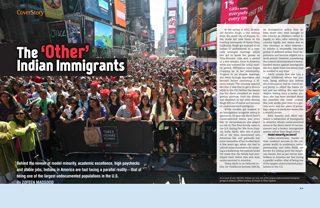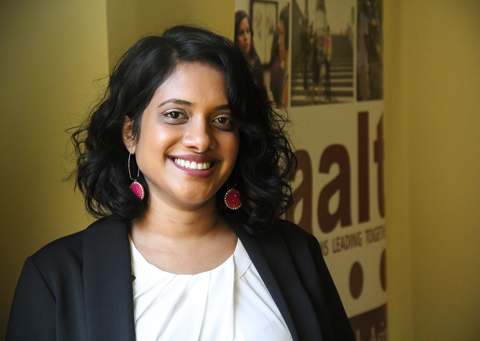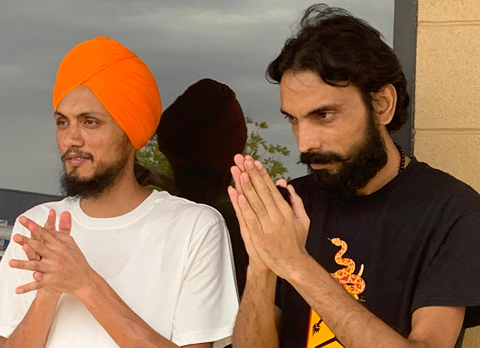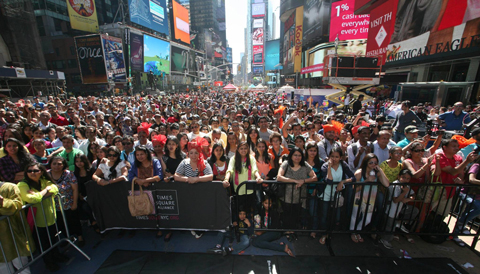The ‘Other’ Indian Immigrants

At a count of over 600,000, Indians are now one of the largest undocumented immigrant groups in America. (Photo courtesy of Diwali at Times Square)
Behind the veneer of model minority, academic excellence, high paychecks and stable jobs, Indians in America are fast facing a parallel reality—that of being one of the largest undocumented populations in the U.S.
In the spring of 2015, 26-year-old Amisha Singh, a shy woman from the small city of Kanpur, India, made her new home in the bustling metropolis of Santa Clara, California. Singh got married to an Indian IT professional in a typically arranged marriage where she got to know her groom on long-distance calls over a period of a few months. Once in America, while she enjoyed the initial marital period, differences soon began cropping up in her relationship. Trapped in an abusive marriage, she went through depression and betrayal before consulting a divorce lawyer. The attorney assured her that it was fine to get a divorce while in the U.S. Neither the lawyer nor the client consulted an immigration attorney. Once the divorce was finalized, to her utter dismay, Singh fell out of status and became an undocumented immigrant.
While Amisha got trapped in an immigration quagmire owing to ignorance, 19-year-old Akriti Patel’s undocumented status was more due to circumstances she played no role in. The Patel family came to the U.S. during the ’80s from Gujarat, India. Akriti, who was 8 years old at the time, assimilated into American life, and gradually lost most memories of her motherland. A few years ago, when she had to submit some documents for attaining a scholarship, her parents broke the news that the family had overstayed their visitor visa and were undocumented in America.
Today Akriti is on Deferred Action for Childhood Arrivals (DACA), an immigration policy that allows those who were brought to the country as children—either illegally, or who, after entering the country legally, lost status due to visa overstays or other reasons— to receive a renewable two-year period of deferred action from deportation and become eligible for a work permit. However, considering the current administration’s heavy-handed stance against immigrants like her, Akriti fears her status may be revoked at any time.
Akriti admits that she had a tough childhood, where her parents, living without any federal aid or insurance, had to crunch every penny to afford the basics for her and her sibling. She says that despite having been a stellar student, she has been mocked about the situation she never created. She now works part-time in a grocery store, and her plans of pursuing a degree in medicine seems like a wishful dream.
Both Amisha and Akriti represent a subsection of immigrants in America whose undocumented status is the direct result of circumstances and a broken immigration system rather than illegal intent.
Model minority no more?
Indian-Americans, thanks to
their outsized success in the corporate
world, in academics, entrepreneurship,
and other fields, are
known for having aced the American
Dream. But as per recent data,
Indians in America are fast facing
a parallel reality—that of being one
of the largest undocumented populations
in the U.S.
While the total number of undocumented immigrants may have gone down in recent times, it may be ironic to know that number of undocumented Asians and particularly Indians is on the rise. According to a study entitled Inside the Numbers: How Immigration Shapes Asian American and Pacific Islander Communities conducted by Los Angeles-based civil rights organization Asian Americans Advancing Justice (AAJC), out of the 10.7 million undocumented immigrants as estimated by Center for Migration Studies, 1.7 million are Asian. This means that approximately 16% of undocumented immigrants in the country are from Asia, making them the third largest group of undocumented immigrants in the country, preceded by Mexicans and Central Americans.
The study also reveals that at 37%, India tops the list of undocumented immigrants from Asian countries. More staggeringly, there was a 72% increase in the number of undocumented Indians between 2010-2017. As per South Asian Americans Leading Together (SAALT), a national South Asian civil rights organization, there are now over 600,000 Indians who are undocumented. More visa overstays were from India than any other country. [See the Sidebar for more statistics.]

(Left) “Because the U.S. continues to provide more H-1B visas than there are green cards available for Indians on H-1B visas to adjust their status, many Indian families are stuck in temporary nonimmigrant H-1B status,” says Megan Essaheb, director of immigration advocacy at Asian Americans Advancing Justice (AAJC). (Photo courtesy of AAJC)
Perpetrators or victims?
On why there is a rising number of undocumented Indians, Megan Essaheb, director of immigration advocacy at AAJC, explains, “For Indian nationals, there are backlogs in both the family-based immigration system and in the employment-based system. This means that family members may have to remain apart for many years. Sometimes they come to the U.S. to join other family members on a
temporary or nonimmigrant visa, such as a tourist visa or a student visa, and when their status runs out, they may overstay their visa for a variety of reasons.”
However, immigration experts maintain that the issue of undocumented status is not really black and white. Essaheb also explains how the ongoing high-skill immigration delays may be contributing to the crisis. She says, “One example is the case of H-1B visa holders. Because the U.S. continues to provide more H-1B visas than there are green cards available for Indians on H-1B visas to adjust their status, many Indian families are stuck in temporary nonimmigrant H-1B status. When the child of an H-1B visa holder turns 21, they lose their H-1B status and if they do not leave the U.S. they may become undocumented.
“Other people make the decision to stay for a variety of reasons such as medical needs, conditions back home or a lack of support network back home. Sometimes, people are waiting in line to get a green card and their sponsor dies causing them to fall out of the line.”
For Sunayana Dumala of Olathe, Kansas, the problem sounds all too familiar. In 2017, Dumala caught national attention when her husband Srinivas Kuchibotla was shot in a mindless racist attack. Following this traumatic experience, she faced another blow—the fear of being rendered out of status. Recounting her horror, she says, “The moment the officer who came to my house that night shared that Srinu was no more, I knew that my status in the U.S. would be in jeopardy—this despite the fact that I had studied, lived, and worked in the country for several years.”
Thanks to intense advocacy, Dumala was able to continue living and working in the U.S.—but not without continuing challenges to her status. She explains, “I was given a visa on humanitarian grounds but even after a year of the tragedy, when I wanted to revisit India for my husband’s memorial, I was told that I may not be able to come back as my H-1B was still in process.”
Dumala was also automatically removed from the green card line because the primary sponsor, her husband, was no more.
Since then, Dumala turned her tragedy into a mission and became an immigration activist. She said, “I realized how, due to outdated immigration laws, so many women and children must be falling out of status every day in America. Many of them may not have the means to fight the system thus rendering them undocumented.”

(Right) Highlighting the fact that most South Asians enter the country legally, Amy Bhatt, a professor and a researcher on transnational migration who has written books on South Asian migration patterns, says, “The line between ‘legal’ and ‘illegal’ is a thin one.”
Amy Bhatt, author and associate professor at the University of Maryland, Baltimore County, teaches gender, globalization, and South Asia. She is a researcher on transnational migration and has written books on South Asian migration patterns. She contradicts the argument that being in an undocumented status is a crime and must be dealt with as such, saying, “The line between ‘legal’ and ‘illegal’ is a thin one. In the case of South Asians, most enter the country on legally issued visas, but can end up overstaying. The problem has gotten worse as the immigration system is extremely backlogged in processing green card applications and people are waiting years before their applications are approved. In that time, they become quite established here and start contributing greatly to the U.S. economy. Some will even buy homes or have children who are born here and are therefore U.S. citizens. For those families, it isn’t so simple to say ‘get out’ if their visas expire. Because of the long delays in ‘legal’ immigration, it isn’t clear-cut to say that people aren’t following the rules or should have to go back to the end of the line.”

(Left) Rekha Sharma-Crawford, an immigration attorney in Kansas City, cites the recent Farmington University scandal where hundreds of Indian students were deported for being enrolled in a fake university as an example of how the system itself victimized migrants.
There have also been recent examples where many have been rendered undocumented, tricked by the system itself. Rekha Sharma-Crawford, an immigration attorney in Kansas City, cites the example of the recent Farmington University scandal where hundreds of Indian students were deported for being enrolled in a fake university. She says, “Fake universities were set up by ICE to trap students who were trying to maintain their status instead of falling out of status. In such instances, the immigration laws first left no opportunity for students to be able to find a legal solution, and then, despite their best efforts to try and meet their legal obligations, they found themselves victimized by the U.S. immigration system itself. It was a catch-22 which was designed to target desperate students trying to do the right thing. That can hardly be characterized as fair.”
Misunderstood and ostracized
21-year-old Anisha Shah carefully guarded her undocumented status through her high school and college years. She knew that her parents held temporary jobs such as housecleaners, dishwashers, and waiters because they would get no permanent job for lack of a social security number. Despite tough times, Shah could not apply for FAFSA (Free Application for Federal Student Aid) and had to pay a whopping out-of-state tuition fee for her first year of college before she could get approved for DACA (Deferred Action for Childhood Arrivals). Even after acquiring her DACA status, she felt stigmatized. She shares, “Most students and even neighbors had no
empathy for our status, and instead thought we were lawbreakers. I have to fight
a dual battle—one with the system and the other
with the society.”
According to SAALT, as of August 2018, there were approximately 2,550 active Indian DACA recipients. Currently there are over 4,500 South Asians who are DACA recipients. Only 13% of the overall 20,000 DACA eligible Indians have applied and received DACA.

(Right) “I fear that most Americans know very little if anything about undocumented youth, including DACA recipients,” says Mark G. Kuczewski, director of the Neiswanger Institute for Bioethics and Health Policy and co-chair of the Dreamer Committee at Loyola University Chicago.
Mark G. Kuczewski, director of the Neiswanger Institute for Bioethics and Health Policy and co-chair of the Dreamer Committee at Loyola University Chicago, acknowledges that Asians are now a rising group among DACA recipients. He says, “I fear that most Americans know very little if anything about undocumented youth, including DACA recipients. Those who have heard of DACA often think that it is a good enough solution and fail to understand the urgent need for a legislative solution such as the DREAM Act [a bill in Congress that would have granted legal status to certain undocumented immigrants who were brought to the United States as children and went to school here]. They don’t understand that even with DACA, an undocumented young person cannot get a federal student loan or buy a full-priced health insurance policy on one of the ACA exchanges. Thus, they are cut off from important opportunities to contribute to our society. Nevertheless, many are excelling and studies show that DACA recipients are managing to enter college at approximately the same rate as their citizen peers.”
The asylum seekers
Another section of the undocumented population is asylum seekers. In the summer of 2019, the case of a 6-year-old child from Punjab,
India, dying in the desert heat after crossing the border with her family may have come as a surprise for many Indian-Americans. Since then, Indian asylum seekers have been in news.

(Left) “South Asians, along with a range of other communities, are increasingly impacted by the militarization of the Southern border, the threat of ICE raids, and indefinite detention,” says Lakshmi Sridaran, Interim Co-Executive Director of South Asian Americans Leading Together (SAALT)
Not only are the journeys dangerous, the conditions in detention facilities themselves endanger the lives of those trapped there. SAALT has tracked and documented a series of abuses that many South Asian asylum seekers have faced in detention facilities across the U.S. Indefinite detention, insufficient religious and language accommodations, and forced solitary confinement have driven many to go on hunger strike to demand their release. Lakshmi Sridaran, Interim Executive Director of SAALT, says,
We have seen an even greater uptick of immigration enforcement under this administration’s brutal policies, specifically in the number of South Asian asylum seekers and refugees. It may seem surprising, but the number of South Asians apprehended at the border has tripled in the last year. South Asians, along with a range of other communities, are increasingly impacted by the militarization of the Southern border, the threat of ICE raids, and indefinite detention.
It is deeply unfortunate and flawed to presume that asylum seekers from all over the world are cheating the system before their cases are even heard. This has resulted in extremely high asylum denial rates and abusive treatment in detention centers along the border. There are so many South Asians impacted right now that need the support of our communities, especially those who are languishing in detention. We urge community members to step up and support fellow South Asians who are under attack by joining our South Asian Rapid Response Network.
Right now, there are five men in a detention facility in rural Louisiana who have been on hunger strike for over 70 days. They’ve been subject to aggressive forced hydration procedures by facility staff and two of them are currently in wheelchairs because of the toll the strike has had on their bodies. Their demands are simple—they want to wait for their asylum court dates outside of detention. These specific cases are among the many we’ve seen in just the past year. The current detention system is robbing people of their dignity—and the only thing that makes sense is a complete overhaul of the detention system itself.

Gurjant Singh (left) and Ajay Kumar carried out a 75-day hunger strike that landed them in a hospital being force fed through a nasal tube before ICE officials finally released them. (Photo courtesy of Attorney Jessica K. Miles)
Megan Essaheb of AAJC shares similar concerns when she says,
The U.S. has long recognized a moral imperative to accept asylum seekers and resettle refugees. Under U.S. and international law such as the 1967 Protocol of the 1951 Convention Relating to the Status of Refugees, which the U.S. is a signatory to, the U.S. has an obligation to accept asylum seekers who seek protection. When people seeking asylum present themselves at our borders, whether an airport or a land border, they have certain due process rights to apply for asylum.
Unfortunately, this administration is seeking to strip those rights from people, illegally turning people away at the Southern border and jailing asylum seekers. By blocking asylum seekers from entering at the ports of entry on the border we have seen more people trying to cross the border through dangerous passages, resulting in tragic deaths, such as the young Indian girl. The U.S. government should be doing everything in its power to prevent the deaths of border crossers.
Contributors to the American economy
A seldom acknowledged fact is that many undocumented immigrants contribute to the society by paying payroll and sales taxes. Researchers have also established that besides contributing in tax revenue, these migrants also reduce American firms’ incentive for offshore jobs.
Amy Bhatt feels that often, undocumented immigrants end up losing more than one imagines. She says, “Our country has benefited historically from underpaid and unpaid labor since its founding. We cannot underestimate the ways in which we have been enriched by the work that immigrants and minorities do, whether it is leading Fortune 500 companies, becoming civic leaders, or starting new and innovative enterprises. But we can’t forget all the ways in which immigrants contribute to running our restaurants, agriculture, motels and hospitality industries, healthcare, and so much more. They work so hard, and because of their immigration status, they are subjected to unfair practices such as wage theft, sexual harassment, intimidation, and more. Because they are unlikely to report employers or others to the authorities, they are in a much more vulnerable situation.”
Megan Essaheb says, “Our system benefits from undocumented labor. Employers often pay submarket wages or take advantage of undocumented immigrants, and as a result many Americans pay for cheaper services. Many undocumented immigrants have payroll taxes taken out of their checks for benefits such as social security and Medicare, which they will never benefit from. Yet no one suggests throwing employers in jail or exiling them.”
The long road ahead
Experts agree that being undocumented in America, especially in the current times, can be anybody’s worst nightmare. The AAJC report sums up steps that should be taken to rectify the problem. It states: “Our immigration system should respect the inherent worth of all people and guard against the unequal, second-class treatment of any members of our
communities. Congress should pass a legalization bill to offer undocumented immigrants in the U.S. a path to citizenship that would include an application process with background checks. Additionally, updates to our immigration system, such as the Reuniting Families Act, would resolve the status of many Asian undocumented immigrants stuck in visa backlogs or facing barriers to adjusting status. Finally, there should be expanded opportunities for low-wage workers to immigrate to the U.S. permanently to work in jobs for which there are labor market needs.”
Mark G. Kuczewski of Loyola University lists how a lack of healthcare affects the undocumented population. He says, “Undocumented immigrants usually work in low-wage jobs that do not provide health insurance. This means that they often have to rely on the emergency room at their local hospital for healthcare. This uncompensated care will cost much more than being sent to a rehabilitation facility. It would be far better if this patient had access to all the mechanisms of the Affordable Care Act and had been able to purchase a policy.”
|
Amy Bhatt sums it up well when she says, “The thing to keep in mind is that our immigration system is extremely complex and changes frequently. It is a maze of laws passed by Congress, rules made by the White House and administrative bodies such as the USCIS and the DHS, and enforced by individual ICE, Customs and Border Patrol, and consular officers. The rules change and are enforced differently at different times. It is hard enough for lawyers and scholars to follow, let alone regular people. I think because of that, we need to stop focusing on ‘illegal’ versus ‘legal’ immigration and shift towards a holistic reform of the system, including amnesty for people who are already here.” |
[A name has been changed in the story on request of the individual.]
Zofeen Maqsood is a U.S.-based journalist who writes extensively on millennial trends and expat issues. She has contributed to some of the biggest newspapers and websites in India and in the U.S.
|
Statistics on undocumented Indians |
|
from the Asian American Justice Center (AAJC) report given to Congress in June 2019: • 2016: number of Indians arrested by Customs & Border Protection (CBP): 3,668 • 2016: percentage of Indian immigrants arrested by CBP who were men: 97% • As of June 2018: number of Indian nationals detained by ICE: 2,376 • In August 2018, 56% of immigrant detainees in Victorville, California were from India and about 40% of detainees at the ICE Imperial Valley detention facility in California were from India. • (2015 – 2018): number of Indians arrested by ICE within the interior of the U.S.: 1,639 • 2018: number of Indians apprehended trying to cross the border: 3,752 • 2018: number of Indian nationals arrested by CBP: at least 4,197 • 2018: number of Indian deportees: 611 Additionally, from ICE’s FY 2019 Enforcement and Removal Operations Report: • FY 2019: number of Indian deportees: 1,616 |

Enjoyed reading Khabar magazine? Subscribe to Khabar and get a full digital copy of this Indian-American community magazine.
blog comments powered by Disqus










